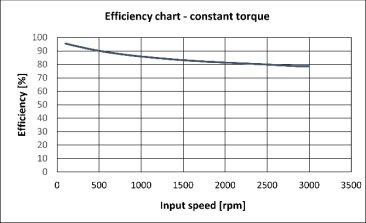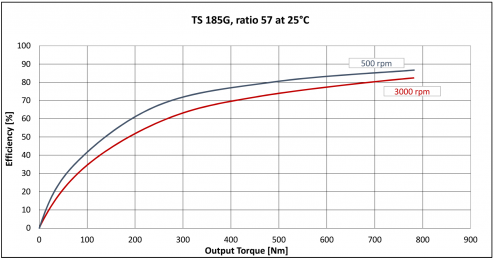
This article is dedicated to explanation of efficiency parameter in TwinSpin® gearboxes and its correct interpretation and application in the design of drive nodes.
Power consumption and overall energy effectiveness of the equipment have been highlighted nowadays in the applications with high precision reduction gears. This trend is even more apparent in mobile applications where the battery is a power source with limited working time till going flat, thus its efficiency significantly affects the equipment functionality and utilization time.
Mechanical efficiency is defined as a proportion between the power entering the reduction gear and power on the output of the reduction gear after speed reduction. We can conclude that gearing mechanism friction influences the efficiency as a proportional parameter, namely the Coulomb friction which is a constant value, as well as viscous friction which is a variable value depending on more parameters. Efficiency is usually stated in percentage (%).
Catalogues issued by some gear manufacturers declare efficiency as a number. Usually it is an efficiency value at nominal load or nominal respectively, and at nominal speed. However, it is incomplete information for purpose of the drive design since reduction gear usually work in various speed regimes with changing value of output torque.
Efficiency is neither a single number nor a constant, thus we can say that it is a function that depends on various parameters and as such, it should be interpreted in the form of a graph.
Parameters as torque, input speed, operating temperature, gear ratio, lubricant type and lost motion value influence the overall efficiency in the TwinSpin® reduction gears.
Torque is a factor with the biggest impact on the resulting mechanical efficiency of reduction gear – see graph No. 1. Measurements of efficiency applicable to maximum torque values equal to nominal values are stated in the catalogue of reduction gears TwinSpin® made by SPINEA®.
Reduction gear efficiency decreases with increasing speed. It is caused by viscous resistance of reduction gear lubricant that increases with increasing input speed. However, the effect of speed is lower than the torque effect, as shown on graph No. 2.


Two heat sources influence the reduction gear. The first heat source refers to ambient heat – temperature. The other heat source refers to temperature depending on heat generated by reduction gear during its operation. Heat generated by the reduction gear depends on the operating regime /duty factor/ that the transmission is operated in.
Gear ratio is a parameter given by the reduction gear design. Gear ratio defines the number of contact areas in the reduction gear that directly influences magnitude of friction in it and subsequent efficiency differences. Twinspin gears with lower ratio have higher efficiency than gears with higher ratios.


Lubricant type – lubricant effect on viscous resistance, thus also its contribution to the efficiency depends on speed and is associated with oil viscosity, or base oil respectively, provided that lubrication grease is used as a lubricant.
Lost Motion – reduction gears TwinSpin® are precision reducers with Lost Motion parameter lower than 1 Arcmin. It is different whether reduction gear is made with initial Lost Motion set up around 0.4 Arcmin or around 0.8 - 1 Arcmin. Lost Motion is below 1 Arcmin in both cases; however heat production will differ in each case because of different friction rates in the reduction gear.
Graph No. 5 Outputs of Twinspin G series transmission efficiency measurement

The type, or so-called series of the reduction gear, significantly affects the efficiency.
Series H – hollowshaft reduction gears sealed on the fast motion input shaft show much lower efficiency than comparable size of series G , T, and E. It´s because of high friction generated by rotational sealing of the shaft on large diameter, and subsequent loss reflected in overall reduction gear efficiency. Thus, method of sealing and number of sealing units has major impact on overall transmission efficiency.
As resulted from the above mentioned statements, efficiency is rather complex phenomenon that cannot be reduced to a single number. Every application is specific and all the above stated factors influencing the resulting efficiency should be taken into account, especially in case of mobile equipment or thermally critical applications, respectively.
In case of interest, SPINEA® will be glad to help you improve your application in the terms of its efficiency, be it in the form of proper adjustment of Lost Motion, recommendation of adequate sealing type or selection of suitable lubricant type for all types of operating conditions and applications.


 SK
SK DE
DE IT
IT RU
RU CN
CN



































